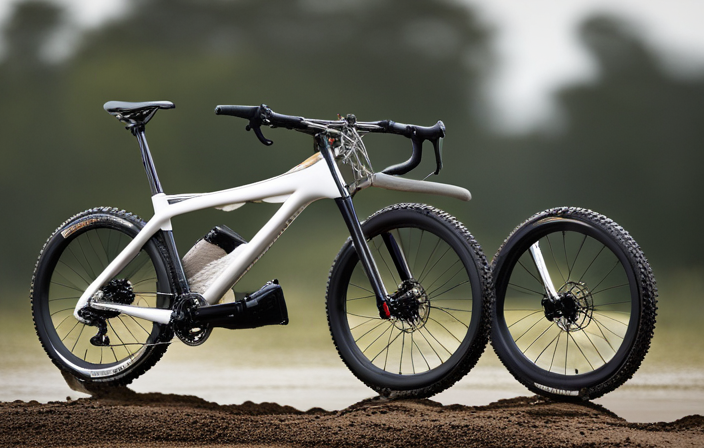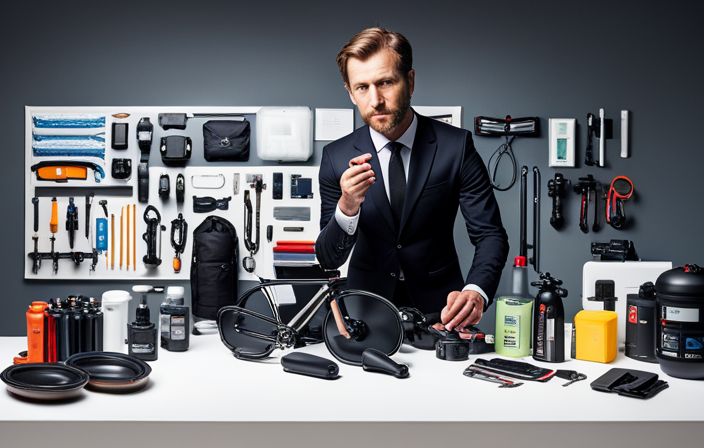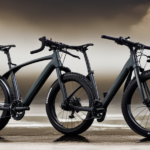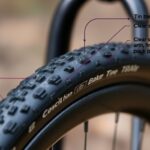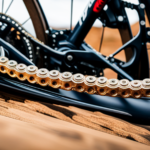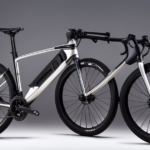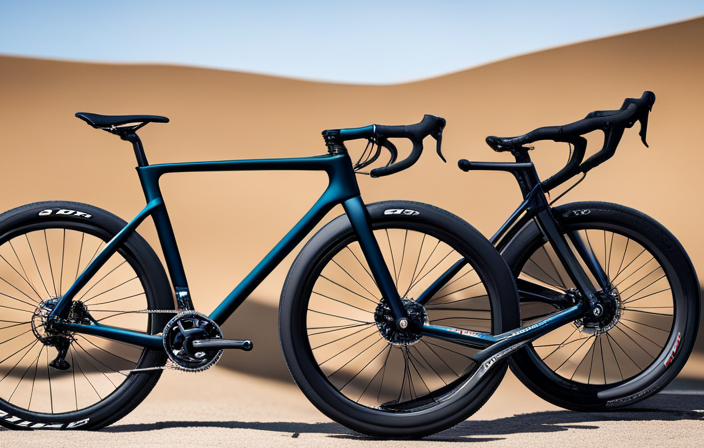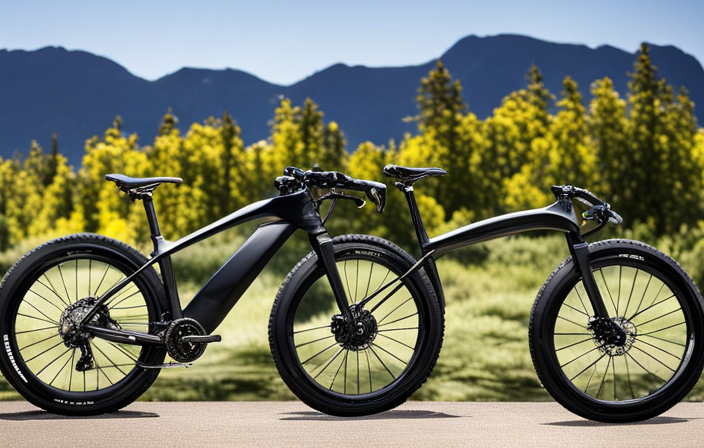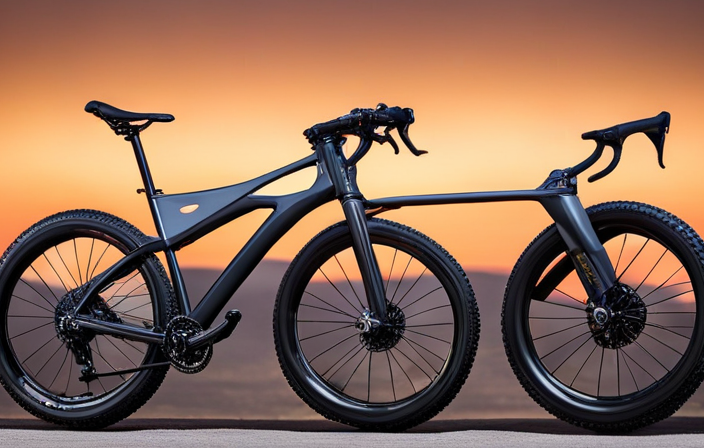Riding a gravel bike can be an exciting adventure, but without proper preparation, it can easily become a messy experience. Just like water rolls off a duck’s back, safeguarding your bike from the elements is essential to preserve its performance and lifespan.
In this article, I’ll guide you through the essential steps to mudproof your gravel bike. From choosing the right fenders to applying mud-proof coatings, we’ll ensure that your two-wheeled companion stays clean and ready for any adventure that comes its way.
Let’s dive in!
Key Takeaways
- Choose the right fenders and mud-resistant tires for mudproofing your gravel bike.
- Install a mudguard on the front fork and use a chain guard or bash guard for added protection.
- Apply mud-proof coatings to the frame and regularly clean and maintain your bike to prevent mud build-up.
- Avoid deep puddles and muddy areas, carry essential tools and supplies, and wear proper footwear for wet conditions.
Choose the Right Fenders
If you’re looking to mudproof your gravel bike, it’s important to choose the right fenders. The first consideration is the material of the fenders. Plastic and aluminum are two common options. Plastic fenders are lightweight and affordable, but they may not be as durable as aluminum ones. Aluminum fenders, on the other hand, offer better durability and can withstand rough terrains.
Next, let’s compare different fender designs. Full coverage fenders provide maximum protection against mud and water splashes by extending close to the ground. They are particularly useful in wet conditions or if you plan on riding through puddles or streams. On the downside, full coverage fenders can be more challenging to install compared to other designs.
Alternatively, partial coverage fenders offer a balance between protection and ease of installation. They typically cover only a portion of the wheel but still provide adequate shielding from muddy splashes.
Now that we’ve discussed choosing the right fenders, let’s move on to another essential step in mudproofing your gravel bike: opting for mud-resistant tires. By selecting tires with aggressive tread patterns and wider widths, you can improve traction in muddy conditions while reducing the chances of getting stuck or sliding.
Incorporating these strategies will significantly reduce mud buildup on your gravel bike for a smoother and cleaner ride overall.
Opt for Mud-Resistant Tires
Choose tires that are specifically designed to resist mud and opt for models with wider treads. When it comes to riding on muddy terrain, having the right tires can make a big difference in your overall performance and enjoyment. There are several mud-resistant tire brands available in the market that offer excellent traction and durability. Look for brands like Maxxis, Schwalbe, or Continental, as they are known for their quality and reliability in challenging conditions.
In addition to choosing the right brand, consider selecting tires with wider treads. Wider treads provide enhanced grip and help shed mud more effectively. This prevents mud from building up between the treads, which can lead to loss of traction and increased rolling resistance.
When riding in muddy conditions, adjusting tire pressure is crucial. Lowering the tire pressure allows for greater contact between the tire and the ground, improving stability and grip. However, be mindful not to go too low as this may result in pinch flats or rim damage.
Now that you have chosen mud-resistant tires with wider treads and adjusted your tire pressure accordingly, it’s time to install a mudguard on the front fork. This will further protect you from muddy splashes while ensuring your bike remains clean and functional during your gravel adventures.
Install a Mudguard on the Front Fork
To keep yourself clean and protect your front wheel from mud splashes, consider installing a mudguard on the front fork. This simple addition to your gravel bike can make a significant difference in maintaining cleanliness and preventing debris buildup.
When it comes to bike maintenance, keeping your bike clean is crucial for its longevity and optimal performance.
A mudguard on the front fork acts as a shield, deflecting mud, water, and other particles away from you and your bike. It prevents them from being flung onto your face, clothes, or even into important components like brakes or drivetrain. By minimizing the amount of dirt that sticks to your frame, you can reduce the frequency of thorough bike cleaning sessions without compromising functionality.
When choosing a mudguard for your gravel bike, opt for one that provides adequate coverage without interfering with tire clearance or affecting ride quality. Look for options specifically designed for gravel bikes that offer durability and easy installation.
Now that you have protected the front wheel from muddy splashes with a mudguard on the front fork, let’s move on to another essential step: using a chain guard or bash guard to safeguard your drivetrain from potential damage caused by flying debris.
Use a Chain Guard or Bash Guard
Now, protect your drivetrain from potential damage caused by flying debris by using a chain guard or bash guard. A chain guard is a protective cover that surrounds the chain, preventing it from coming into contact with rocks, branches, or other objects on the trail. It also helps keep your pants or shoelaces from getting caught in the chain. On the other hand, a bash guard is a sturdy plate that attaches to the crankset and protects the chainring from impacts. This is especially useful when riding over rough terrain where rocks and obstacles are common.
Installing a chain guard offers several benefits. Firstly, it extends the lifespan of your drivetrain components by preventing them from getting damaged by mud and debris. Secondly, it reduces maintenance requirements as there will be less need for cleaning and lubrication. Lastly, it enhances safety by minimizing the risk of accidents caused by unexpected chain derailments.
To give you an idea of how these protective accessories can benefit your gravel bike setup, take a look at this table:
| Chain Guard Benefits | Bash Guard Installation |
|---|---|
| Protects drivetrain components | Attaches to crankset |
| Prevents damage from mud and debris | Sturdy plate construction |
| Reduces maintenance requirements | Minimizes risk of chain derailment |
By installing a chain guard or bash guard on your gravel bike’s drivetrain, you can ensure its longevity and reliability even in muddy conditions. Now let’s move on to applying mud-proof coatings to further protect our bike frame against dirt and grime buildup without compromising its performance capabilities.
Apply Mud-Proof Coatings to the Frame
For added protection against dirt and grime buildup, apply mud-proof coatings to your frame. Mud-proof coatings are specifically designed to repel mud and water, keeping your gravel bike clean and in optimal condition.
Here are some key benefits of using mudproof coatings:
-
Enhanced durability: Mud-resistant paint options provide an extra layer of protection for your bike’s frame, shielding it from scratches, chips, and corrosion caused by mud and water exposure.
-
Easy maintenance: With a mudproof coating, cleaning your bike becomes a breeze. The slick surface prevents mud from sticking to the frame, allowing you to simply wipe it off with a cloth or hose it down without the need for extensive scrubbing.
-
Improved performance: By reducing the amount of dirt and debris that accumulates on your bike during rides, mudproof coatings help maintain smooth operation of moving parts such as gears and chains. This translates into better shifting performance and longer component lifespan.
-
Aesthetic appeal: Apart from their functional benefits, these coatings come in various colors and finishes, allowing you to customize the look of your bike while protecting it from the elements.
To further safeguard your gravel bike against muddy conditions, let’s move on to covering the bottom bracket with a protective sleeve.
Cover the Bottom Bracket with a Protective Sleeve
Covering the bottom bracket with a protective sleeve helps prevent mud and water from damaging sensitive components. The protective sleeve acts as a barrier, shielding the bottom bracket from the harsh elements encountered during off-road riding. It not only keeps mud and water out but also prevents dirt and debris from getting inside, which can lead to premature wear and tear.
To give you an idea of the benefits of using a protective sleeve, take a look at this table:
| Benefits of Using a Protective Sleeve |
|---|
| Shields bottom bracket from mud and water |
| Prevents dirt and debris accumulation |
| Extends lifespan of bottom bracket |
| Reduces maintenance and repair costs |
Choosing the right material for your protective sleeve is crucial. The best materials are durable, lightweight, and resistant to abrasion. Neoprene sleeves are popular due to their excellent waterproof properties, flexibility, and ability to withstand rough conditions. Additionally, nylon or synthetic fabrics reinforced with PVC provide great protection against moisture while being highly durable.
Now that we have covered how to protect the bottom bracket with a protective sleeve let’s move on to another essential step in mudproofing your gravel bike: using waterproof grease on moving parts.
Use Waterproof Grease on Moving Parts
To protect the moving parts of your gravel bike from water and mud, make sure to use waterproof grease. Waterproof grease is specifically designed to repel water and prevent it from seeping into the bearings and other components of your bike. By using waterproof grease, you can extend the lifespan of your bike’s moving parts and ensure smooth operation even in wet and muddy conditions.
Here are five benefits of using waterproof grease:
- Protection against rust: Waterproof grease creates a barrier that prevents moisture from reaching metal surfaces, reducing the risk of rust formation.
- Enhanced durability: The thick consistency of waterproof grease helps it stay in place for longer periods, providing long-lasting protection for your bike’s components.
- Reduced friction: Waterproof greases often contain additives that minimize friction between moving parts, resulting in smoother performance and improved efficiency.
- Compatibility with various materials: Different types of waterproof greases are available to suit different materials, including plastic, rubber, and metal.
- Easy application: Applying waterproof grease is a straightforward process that can be done at home with basic tools.
By keeping the moving parts of your gravel bike protected with waterproof grease, you’ll ensure their longevity and optimal performance. Now let’s move on to the next step – keeping your chain lubricated.
Keep Your Chain Lubricated
Make sure you regularly lubricate your chain to ensure smooth operation and prevent unnecessary wear and tear. Chain maintenance is a crucial aspect of mudproofing your gravel bike, as the chain is exposed to dirt, debris, and moisture during off-road rides. By following proper lubrication techniques, you can extend the lifespan of your chain and improve overall performance.
To start, clean your chain thoroughly using a degreaser and brush to remove any built-up dirt or grime. Once clean, apply a high-quality bike-specific lubricant onto the inner side plates of the chain while rotating the pedals backward. This ensures that the lubricant penetrates into all moving parts for optimal coverage.
Avoid over-lubricating as excess oil can attract more dirt and create a messy buildup. Instead, aim for a thin film of lubricant that coats each link without dripping excessively. It’s also important to choose the right type of lube for your riding conditions – wet lubes are better suited for muddy environments while dry lubes work well in dusty conditions.
By properly maintaining and lubricating your chain, you’ll experience smoother shifting, reduced friction, and less noise during rides. This will help protect your drivetrain from premature wear caused by mud and water exposure.
Transitioning into the next section about avoiding deep puddles and standing water: Now that we’ve covered proper chain maintenance techniques…
Avoid Deep Puddles and Standing Water
When riding, you’ll want to steer clear of deep puddles and standing water to prevent damage to your chain and other components. Not only can these wet conditions lead to rust and corrosion, but they can also cause dirt and debris to accumulate on your bike. To illustrate the importance of avoiding deep puddles and standing water, consider the following table:
| Hazards | Potential Damage |
|---|---|
| Puddles | Water splashing onto chain, causing rust |
| Standing Water | Dirt and debris accumulation on bike |
To protect your gravel bike from these hazards, it’s crucial to choose proper footwear that provides sufficient grip in wet conditions. Look for shoes with a non-slip sole or even invest in waterproof shoe covers. Additionally, regular bike maintenance is key. After each ride through wet conditions, thoroughly clean your bike using mild soap and water. Pay special attention to areas where dirt tends to accumulate such as the chainrings, cassette, and derailleur pulleys.
By avoiding deep puddles and standing water while ensuring proper footwear and performing regular bike maintenance, you can extend the lifespan of your gravel bike’s components. In the next section, we will explore how learning proper bike handling techniques in mud can further enhance your riding experience without compromising performance."
Learn Proper Bike Handling Techniques in Mud
Mastering proper bike handling techniques in muddy conditions can greatly enhance your riding experience. When it comes to riding in mud, having the right skills and knowledge can make all the difference. Proper bike handling techniques in mud involve a combination of body positioning, balance, and control.
Firstly, it is important to keep your weight centered over the bike. This helps maintain stability and prevents you from getting stuck or losing control. By shifting your weight back when going downhill or through deep mud patches, you can improve traction and avoid sliding.
Secondly, maintaining a relaxed grip on the handlebars is crucial. This allows for better control and maneuverability as you navigate through muddy terrain. In addition, using a wider handlebar grip provides more leverage when steering in challenging conditions.
Lastly, learning how to use your brakes effectively in muddy conditions is essential. Feathering the brakes instead of squeezing them hard prevents skidding and helps maintain traction.
By mastering these proper bike handling techniques in mud, you will experience several benefits. You will have increased confidence while riding in challenging conditions, improved control over your bike’s movements, and reduced chances of accidents or injuries.
Transition: Now that we’ve covered proper bike handling techniques in mud, let’s move on to another important aspect – cleaning your bike thoroughly after each ride.
Clean Your Bike Thoroughly After Each Ride
After every ride, it’s important to thoroughly clean your bike. Proper bike maintenance is crucial for the longevity and performance of your gravel bike, especially when riding in muddy conditions. Cleaning your bike not only keeps it looking good but also helps prevent the buildup of dirt, grime, and mud that can damage components over time.
To start, use a hose or bucket of water to wet your bike. Ensure all parts are soaked before applying a mild detergent or bike-specific cleaner to a sponge or brush. Gently scrub all surfaces, including the frame, wheels, drivetrain, and brakes. Pay extra attention to areas with heavy mud accumulation.
After scrubbing away the dirt, rinse off the soap using clean water. Take care not to spray directly into sensitive areas like bearings or headset cups. Use a soft cloth or towel to dry off excess moisture from the bike.
Finally, inspect your bike for any signs of wear and tear or loose components that may have been hidden by the mud. This cleaning routine not only enhances the appearance of your gravel bike but also ensures its optimal performance.
Cleaning your bike thoroughly after each ride is an essential step in maintaining its longevity and functionality—now let’s move on to investing in a reliable bike cleaning kit.
Invest in a Bike Cleaning Kit
To properly maintain your bike’s cleanliness, consider investing in a bike cleaning kit. A good cleaning kit will provide you with the necessary tools and products to effectively clean your gravel bike after muddy rides.
Here are some of the benefits of using a bike cleaning kit:
-
Convenience: A cleaning kit usually contains all the essential items you need in one package, saving you time and effort searching for individual cleaning supplies.
-
Effectiveness: The specialized brushes, degreasers, and chain cleaners included in a bike cleaning kit are designed specifically for bike components, ensuring thorough cleaning without causing any damage.
-
Protection: Regularly cleaning your bike with a dedicated kit helps remove dirt, mud, and grime that can accumulate on various parts. This reduces wear and tear on components and extends their lifespan.
-
Improved Performance: Keeping your gravel bike clean enhances its performance by allowing smooth operation of gears, brakes, and suspension systems.
-
Overall Maintenance: By regularly employing proper bike cleaning techniques using the right products from a dedicated kit, you contribute to overall maintenance efforts that keep your gravel bike running smoothly.
After thoroughly cleaning your gravel bike with a reliable cleaning kit, it is crucial to store it in a dry and sheltered area to prevent further dirt buildup.
Store Your Bike in a Dry and Sheltered Area
After investing in a bike cleaning kit to keep my gravel bike looking pristine, I quickly realized that proper storage is just as important in preventing mud and moisture from wreaking havoc on its components. It’s essential to store your bike in a dry and sheltered area to protect it from the elements.
Moisture prevention is key when it comes to bike storage. Dampness can lead to rust, corrosion, and damage to sensitive parts such as the drivetrain and bearings. Therefore, finding a location that minimizes exposure to humidity is crucial. A garage or shed with good ventilation is ideal, as it helps maintain a consistent temperature while allowing any excess moisture to escape.
To further safeguard against moisture, consider using a waterproof cover specifically designed for bikes. This will provide an extra barrier of protection against rain or condensation that may accumulate in the storage space.
By storing my gravel bike in a dry and sheltered area with minimal exposure to moisture, I can greatly reduce the risk of costly repairs down the line.
Now that we’ve covered proper bike storage techniques, let’s move on to how regularly inspecting and maintaining your bike’s components can ensure optimal performance.
Regularly Inspect and Maintain Your Bike’s Components
Regularly inspecting and maintaining the components of your bicycle is crucial for optimal performance. A thorough bike inspection should be conducted before and after every ride to ensure that all parts are in good working condition. Start by checking the tires for any signs of wear or damage, such as cuts or punctures. Inflate them to the recommended pressure level if necessary.
Next, examine the brakes to make sure they are properly aligned and have sufficient brake pad thickness. Adjust or replace them as needed. Moving on to the drivetrain, inspect the chain for dirt and grime buildup, and clean it with a degreaser if necessary. Check the gears for smooth shifting and adjust the derailleurs if needed.
Additionally, pay attention to other key components such as pedals, handlebars, saddle, and wheels. Tighten any loose bolts or screws and lubricate moving parts like bearings and pivots regularly. By conducting these routine inspections and promptly addressing any issues, you can prolong the lifespan of your bike’s components and ensure a safe riding experience.
Transitioning into considering a bike maintenance course or workshop: While regular inspections and maintenance can be done at home with basic tools, there is always more to learn about caring for your bike. Consider attending a bike maintenance course or workshop to further enhance your knowledge and skills in keeping your gravel bike in top shape.
Consider a Bike Maintenance Course or Workshop
Consider attending a bike maintenance course or workshop to enhance your knowledge and skills in keeping your bicycle in top shape. Investing time and effort into learning proper bike maintenance techniques can greatly benefit you as a gravel bike rider. Not only will it save you money in the long run by reducing the need for frequent repairs, but it will also ensure that your bike is always ready for any muddy adventure.
When choosing a bike maintenance course or workshop, it’s important to find one that suits your needs and goals. Look for courses that cover topics such as cleaning and lubricating bike components, adjusting brakes and gears, replacing worn-out parts, and troubleshooting common issues. Additionally, consider workshops that offer hands-on experience so you can practice what you learn under the guidance of experienced instructors.
Attending a bike maintenance course or workshop will provide you with valuable knowledge on how to properly care for your gravel bike. You’ll learn essential skills that will allow you to confidently maintain your own bicycle, saving time and money on professional repairs. By investing in your education, you’ll be equipped with the necessary tools to keep your gravel bike mudproof and performing at its best on every ride.
Frequently Asked Questions
How often should I clean my bike after riding in muddy conditions?
I typically clean my bike immediately after riding in muddy conditions to prevent any damage or corrosion.
The cleaning frequency really depends on the severity of the mud and how often you ride in such conditions.
It is recommended to use mud resistant products, such as specific degreasers and brushes, to effectively remove the dirt.
Regularly inspecting and maintaining your bike will help keep it in optimal condition for future rides.
Can I use regular grease on my bike’s moving parts or is waterproof grease necessary?
Using regular grease on your bike’s moving parts may seem cost-effective, but it may not protect well in muddy conditions. Waterproof grease is designed to resist water and mud, preventing corrosion and reducing friction. Studies have shown that using waterproof grease can increase component lifespan by up to 30%. While regular grease might work in normal conditions, investing in waterproof grease is highly recommended for off-road riding in muddy terrain.
Are there any specific bike handling techniques I should learn for riding in mud?
When it comes to riding a gravel bike in muddy conditions, there are several important bike handling techniques and mud riding tips to keep in mind.
First, maintain an upright position with a relaxed grip on the handlebars to maximize control.
Use a wider stance for stability and try to avoid sudden movements or jerky turns.
Additionally, feathering the brakes can help prevent skidding on slippery surfaces.
Finally, practice weight shifting and leaning into turns for better traction and balance.
How often should I inspect and maintain my bike’s components?
Inspecting and maintaining my bike’s components regularly is crucial to prevent rust and ensure optimal performance.
Just like tending to a well-guarded garden, I must protect my bike from the corrosive elements of moisture and dirt.
Regularly cleaning and lubricating the chain is of utmost importance as it directly affects power transfer and overall efficiency.
By dedicating time to proper maintenance, I can safeguard my bike’s longevity and enjoy smooth rides for miles to come.
Where can I find a bike maintenance course or workshop?
I recommend looking for bike maintenance classes or workshops in your local area. These courses can provide you with valuable knowledge and skills to effectively maintain and repair your bike.
Additionally, there are numerous resources available online that offer step-by-step tutorials and guides for DIY bike repair. By learning how to properly care for your bike, you can ensure its longevity and optimal performance on the trails.
Conclusion
Well, there you have it, folks! You’re now equipped with all the knowledge needed to mudproof your beloved gravel bike.
From choosing the right fenders to applying mud-proof coatings, we’ve covered it all.
Just imagine yourself gracefully cruising through muddy trails, your bike untouched by any speck of dirt. It’s like gliding on a cloud of cleanliness!
So go ahead and put these tips into action, and let your gravel bike shine through even the muddiest adventures.
Happy riding!
